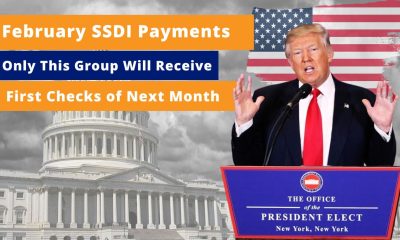Finance
2 Tax Increases Americans Might Support to Preserve Social Security — and 1 They Won’t Willingly Make

The future of the United States’ Social Security program remains uncertain. With projections suggesting that its retirement trust fund may deplete in less than ten years, the nation is grappling with how to ensure its long-term viability.
Recently, a survey of over 2,200 Americans aged 21 and older, conducted by prominent organizations such as the National Academy of Social Insurance, AARP, and the U.S. Chamber of Commerce, explored potential solutions to address the funding gap.
Proposals for Reforming Social Security
The survey revealed several proposed changes to the Social Security system, with varied responses from the public.
Some suggestions gained widespread support across political and demographic groups, while others sparked strong opposition.
Below are the three key proposals that emerged from the survey, highlighting what Americans believe would address the financing gap.
1. Collect Payroll Taxes on Incomes Over $400,000
Proposal Details:
The suggestion is to maintain the current taxable earnings cap but impose Social Security contributions on earnings exceeding $400,000.
Public Opinion:
This proposal received strong support from the survey participants. Many Americans agree that higher earners should contribute more to the Social Security system to help close the growing funding gap.
Potential Impact:
Currently, the maximum income subject to Social Security payroll taxes for 2025 is capped at $176,100. Under the proposed change, individuals earning more than $400,000 annually would pay additional taxes into the system.
This adjustment could significantly boost the program’s financial health, as it would generate more revenue from the wealthiest Americans.
2. Increase the Payroll Tax Rate
Proposal Details:
This proposal calls for an increase in the payroll tax rate, raising it from 6.2 percent to 7.2 percent for both employees and employers.
Public Opinion:
The proposal also garnered strong support across various groups. Respondents expressed a willingness to accept higher taxes on themselves in order to secure the future of the Social Security program.
Potential Impact:
Currently, the payroll tax rate is set at 12.4 percent, which is split between workers and employers. Individuals who are self-employed are responsible for paying the full 12.4 percent.
The new proposal suggests a gradual increase in the payroll tax to 14.4 percent, which respondents see as a fair contribution to strengthen Social Security’s long-term sustainability.
3. Raise the Full Retirement Age
Proposal Details:
The proposal suggests gradually increasing the full retirement age from 67 to 69.
Public Opinion:
This suggestion was met with strong disapproval. A significant number of respondents expressed their objection to raising the retirement age further, indicating that they are already wary of the current increase.
Potential Impact:
The full retirement age was originally set at 65, but over time, it has increased to 67 in an effort to bolster the program’s finances.
Raising the age further may help reduce the number of people claiming benefits at an earlier age, thus alleviating some of the financial strain on the system. However, the survey revealed that this solution is not favored by many Americans.
Summary Table of Proposed Changes and Public Opinion
| Proposal | Public Opinion | Potential Impact |
|---|---|---|
| Collect Payroll Taxes on Earnings Above $400K | Strong support | Higher earners contribute more, increasing revenue |
| Increase Payroll Tax Rate from 6.2% to 7.2% | Strong support | Additional tax revenue strengthens the Social Security fund |
| Raise the Full Retirement Age to 69 | Strong aversion | Delays benefits, but unpopular with the public |
The future of Social Security hinges on finding solutions to the program’s financing issues. The proposed changes, such as collecting additional taxes from higher earners, increasing the payroll tax rate, and raising the retirement age, represent various potential paths forward.
While there is strong support for the first two proposals, there is significant resistance to raising the retirement age further. Addressing these challenges requires finding a balance that will ensure the sustainability of the Social Security system without placing an undue burden on any group of Americans.
FAQs
What is the current maximum income for Social Security payroll taxes?
The maximum income subject to payroll taxes is $176,100 in 2025.
How does raising the payroll tax rate impact workers?
If the payroll tax rate is increased, workers would see a slight reduction in their paychecks. However, the increased tax would help secure the future of the Social Security system.
What would be the impact of raising the full retirement age?
Raising the full retirement age would delay the age at which individuals could start claiming Social Security benefits, potentially helping the program’s finances. However, it was met with strong opposition from survey participants.
-

 Government Aid3 months ago
Government Aid3 months agoFebruary SSDI Payments: Only This Group Will Receive the First Checks of Next Month
-

 Finance2 months ago
Finance2 months agoRare Bicentennial Quarter Worth $15 Million
-

 Government Aid2 months ago
Government Aid2 months agoSocial Security Announces 2025 Check Increase, But a 23% Reduction is Expected Soon
-

 Finance3 months ago
Finance3 months agoThe Lincoln Wheat Penny Worth $5 Million- Still Circulating Today
-

 Finance3 months ago
Finance3 months agoRare Coins: The 1964 D Lincoln Penny Errors You Should Know About
-

 Government Aid2 months ago
Government Aid2 months agoIRS to Distribute Stimulus Checks to Millions- Find Out How to Claim Yours
-

 Finance3 months ago
Finance3 months ago1970-D Kennedy Half Dollar- A Rare Coin Worth Over $150,000 Still in Circulation!
-

 Government Aid3 months ago
Government Aid3 months agoThe Complete February SSDI Payment Schedule: Discover When You’ll Receive Your Disability Benefits









